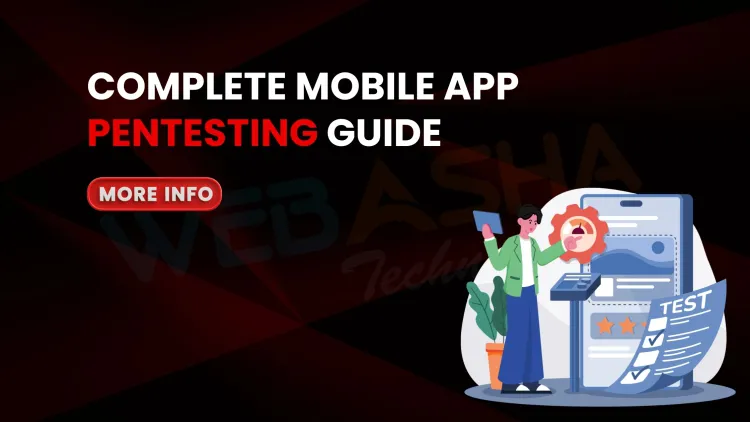Mobile App Pentesting Guide | Tools, Methodology & Commands for Android & iOS
Discover what mobile app pentesting is, its importance, tools like MobSF and Frida, OWASP MASVS compliance, key vulnerabilities in Android/iOS apps, and step-by-step testing methodology. Learn to test mobile apps securely and effectively using advanced tools and techniques.

Table of Contents
- What is Mobile App Pentesting?
- Why is Mobile App Pentesting Important?
- Types of Mobile App Vulnerabilities
- Mobile App Pentesting Methodology
- Best Tools for Mobile App Pentesting
- Common Pentesting Scenarios
- OWASP Mobile Top 10 – Key Focus Areas
- Tips for Effective Mobile Pentesting
- Sample Mobile App Pentest Report Sections
- Compliance Standards for Mobile Apps
- Conclusion
- Frequently Asked Questions (FAQs)
With the explosive growth of mobile applications across Android and iOS platforms, mobile app pentesting (penetration testing) has become a crucial element of cybersecurity. From online banking to healthcare apps, mobile platforms handle highly sensitive data that cybercriminals actively target. Mobile app pentesting helps organizations identify and remediate vulnerabilities before malicious actors exploit them. In this blog, we explore what mobile pentesting is, the tools used, methodologies followed, and real-world best practices.
What is Mobile App Pentesting?
Mobile app pentesting is the process of simulating attacks on a mobile application to find security weaknesses that an attacker could exploit. It involves analyzing the application code, APIs, backends, network communication, and even the device storage mechanisms to identify potential vulnerabilities.
Mobile app pentesting targets two major platforms:
-
Android (APK-based apps)
-
iOS (IPA-based apps)
Why is Mobile App Pentesting Important?
-
Data Protection: Prevents data leakage, unauthorized access, and privacy violations.
-
Compliance: Ensures adherence to standards like OWASP MASVS, HIPAA, PCI-DSS, and GDPR.
-
Secure Coding Validation: Validates whether developers follow secure coding guidelines.
-
Brand Trust: Prevents reputation damage due to mobile app breaches.
-
Business Continuity: Reduces the risk of mobile threats affecting business operations.
Types of Mobile App Vulnerabilities
Common security issues uncovered during pentesting include:
-
Insecure Data Storage (e.g., storing passwords in plain text)
-
Insecure Communication (no HTTPS or weak TLS)
-
Improper Authentication or Session Handling
-
Code Tampering and Reverse Engineering
-
Broken Cryptography
-
Client-Side Injection (JavaScript, SQL, etc.)
-
Insecure WebView implementations
-
Poor implementation of permissions and intents
Mobile App Pentesting Methodology
A standard mobile application penetration testing process follows a structured approach:
1. Information Gathering
-
Identify app architecture (native/hybrid)
-
Fetch APK/IPA files
-
Perform static analysis using tools like JADX, MobSF
2. Static Analysis
-
Review the source code for hardcoded secrets, API keys, or security misconfigurations.
-
Check
AndroidManifest.xml,Info.plist, certificate pinning status, and logging mechanisms.
3. Dynamic Analysis
-
Install the app on an emulator or rooted/jailbroken device
-
Use proxy tools like Burp Suite to intercept and analyze traffic
-
Look for insecure API communication and response leaks
4. Network Traffic Analysis
-
Ensure all data transmitted is encrypted
-
Identify if tokens or credentials are being leaked
5. API Testing
-
Test APIs for authentication bypass, rate limiting, and injection attacks
-
Tools: Postman, OWASP ZAP, Burp Repeater
6. Reverse Engineering
-
Use Frida, Ghidra, or JADX to reverse engineer the app
-
Try patching the app to bypass login, payment, or licensing
7. Exploitation & Reporting
-
Try exploiting any vulnerabilities found
-
Document proof-of-concepts (PoCs)
-
Provide a remediation guide and risk assessment
Best Tools for Mobile App Pentesting
| Tool | Description |
|---|---|
| MobSF | All-in-one automated pentest tool for Android/iOS |
| Frida | Dynamic instrumentation toolkit for code injection |
| Burp Suite | Proxy tool to intercept and test network traffic |
| JADX | Converts APKs into readable Java source code |
| Drozer | Android testing framework for device attacks |
| Xcode Tools | Essential for iOS testing on macOS |
| Ghidra | Reverse engineering and binary analysis |
| AppUse | Android pentesting VM with pre-installed tools |
Common Pentesting Scenarios
-
Testing for Root/Jailbreak Detection bypass
-
Bypassing SSL Pinning with tools like Frida
-
Interception of API tokens
-
Tampering with In-App Purchases
-
Extracting sensitive data from local storage or memory
-
Testing app behavior on rooted devices
✅ OWASP Mobile Top 10 – Key Focus Areas
-
Improper Platform Usage
-
Insecure Data Storage
-
Insecure Communication
-
Insecure Authentication
-
Insufficient Cryptography
-
Insecure Authorization
-
Client Code Quality Issues
-
Code Tampering
-
Reverse Engineering
-
Extraneous Functionality
Tips for Effective Mobile Pentesting
-
Always test in a controlled lab or with explicit permission
-
Use both rooted/jailbroken and stock devices
-
Enable verbose logs to detect errors
-
Simulate slow network connections to observe timeouts
-
Check for certificate pinning and crash logs
-
Use automation tools to complement manual testing
Sample Mobile App Pentest Report Sections
-
Executive Summary
-
App Overview
-
Threat Model
-
Tools Used
-
Test Cases and Results
-
Severity Ratings (CVSS)
-
PoC Screenshots
-
Recommendations
-
Compliance Mapping (e.g., to OWASP MASVS)
Compliance Standards for Mobile Apps
| Standard | Relevance |
|---|---|
| OWASP MASVS | Mobile App Security Verification Standard |
| PCI-DSS | Payment Card Industry compliance |
| HIPAA | Healthcare data protection |
| GDPR | European data protection |
| ISO/IEC 27001 | Information security management |
Conclusion
Mobile app pentesting is not just for enterprises—startups and small businesses should adopt it too. From analyzing APKs to monitoring network requests and performing dynamic attacks, this discipline helps you stay ahead of cybercriminals. A well-structured pentest enhances trust, ensures compliance, and hardens your mobile infrastructure.
Don’t wait until an incident occurs—integrate mobile app pentesting into your SDLC and protect your apps before attackers exploit the loopholes.
Frequently Asked Questions (FAQs)
What is mobile app pentesting?
Mobile app pentesting is the process of testing mobile applications for vulnerabilities that could be exploited by attackers.
Why is mobile app pentesting important?
It helps detect security flaws before attackers exploit them, ensuring data protection and compliance.
What tools are used for mobile app penetration testing?
Common tools include MobSF, Frida, Burp Suite, Drozer, JADX, and Ghidra.
How do I start mobile app pentesting?
Begin with static analysis of the APK/IPA, move to dynamic testing, and then perform API and network analysis.
What is MobSF?
Mobile Security Framework (MobSF) is an automated tool for mobile app security testing of Android and iOS apps.
What is Frida used for?
Frida is a dynamic instrumentation toolkit used to hook into apps and modify their behavior at runtime.
Can Burp Suite intercept mobile app traffic?
Yes, Burp Suite can capture and analyze HTTP/HTTPS traffic from mobile devices.
What is OWASP MASVS?
OWASP Mobile Application Security Verification Standard is a framework to ensure mobile app security.
How do I bypass certificate pinning?
You can use tools like Frida or Objection to hook and bypass SSL pinning in mobile apps.
What are insecure mobile app vulnerabilities?
Common ones include insecure storage, weak encryption, broken authentication, and improper session handling.
What are static and dynamic analysis?
Static analysis inspects app code without running it, while dynamic analysis tests the app while it runs on a device.
What is the difference between Android and iOS pentesting?
Android allows more flexibility with reverse engineering, while iOS requires jailbreaking and has stricter permissions.
What is the use of Drozer?
Drozer is a tool for Android app assessment, helping find exposed components and vulnerabilities.
How to reverse engineer an APK file?
Use JADX or apktool to decompile and analyze the source code and configurations.
Is mobile app pentesting legal?
Yes, when done with proper permission or within a test lab environment.
What is in-app purchase tampering?
It refers to bypassing payment logic to unlock premium features without actual payment.
What is dynamic instrumentation?
It refers to modifying app behavior during runtime, often using Frida or similar tools.
How can I test API security in mobile apps?
Use tools like Postman or Burp Repeater to send crafted requests to app APIs.
What is insecure data storage?
When apps store sensitive information (like passwords) unencrypted in local storage.
Can I pentest apps on emulators?
Yes, most Android emulators support pentesting, though some apps detect emulated environments.
How to test jailbroken or rooted devices?
Use rooted Android or jailbroken iPhones to test advanced attacks like privilege escalation.
What are .ipa and .apk files?
IPA is the iOS app file format, while APK is used for Android apps.
How do you test for session management issues?
Check if tokens are invalidated after logout and if sessions expire properly.
What is obfuscation in apps?
It is a technique to make code harder to understand to prevent reverse engineering.
What is secure coding?
It’s writing code that avoids common vulnerabilities and follows secure development practices.
Can I automate mobile app pentests?
Yes, partially—using tools like MobSF, ZAP, and scripting with Frida or ADB.
What are crash logs and why are they important?
Crash logs can reveal stack traces and sensitive data that attackers can use to exploit the app.
How does root detection affect pentesting?
Apps with root detection can restrict testing on rooted devices; testers must bypass this logic.
What are side-loading risks?
Installing APKs from unofficial sources can introduce malware and vulnerabilities.
How do I write a mobile pentest report?
Include an executive summary, technical findings, CVSS scores, screenshots, and recommendations.












![Top 10 Ethical Hackers in the World [2025]](https://www.webasha.com/blog/uploads/images/202408/image_100x75_66c2f983c207b.webp)


![[2025] Top 100+ VAPT Interview Questions and Answers](https://www.webasha.com/blog/uploads/images/image_100x75_6512b1e4b64f7.jpg)







